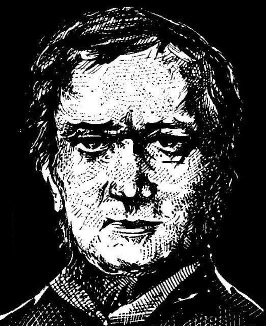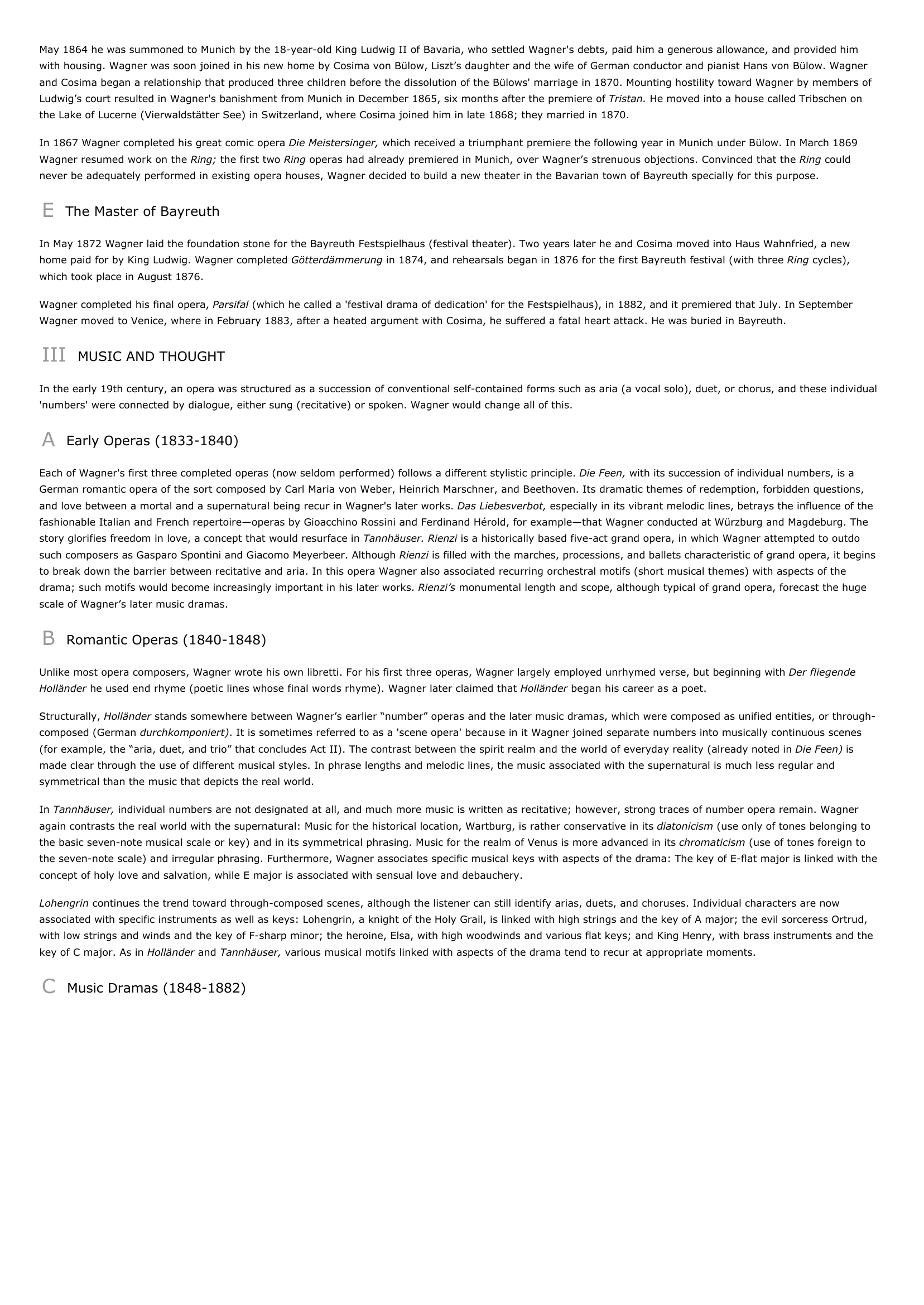Richard Wagner I INTRODUCTION Richard Wagner (1813-1883), German composer, conductor, and essayist, one of the most influential cultural figures of the 19th century.
Publié le 12/05/2013
Extrait du document


«
May 1864 he was summoned to Munich by the 18-year-old King Ludwig II of Bavaria, who settled Wagner's debts, paid him a generous allowance, and provided himwith housing.
Wagner was soon joined in his new home by Cosima von Bülow, Liszt’s daughter and the wife of German conductor and pianist Hans von Bülow.
Wagnerand Cosima began a relationship that produced three children before the dissolution of the Bülows' marriage in 1870.
Mounting hostility toward Wagner by members ofLudwig’s court resulted in Wagner's banishment from Munich in December 1865, six months after the premiere of Tristan. He moved into a house called Tribschen on the Lake of Lucerne (Vierwaldstätter See) in Switzerland, where Cosima joined him in late 1868; they married in 1870.
In 1867 Wagner completed his great comic opera Die Meistersinger, which received a triumphant premiere the following year in Munich under Bülow.
In March 1869 Wagner resumed work on the Ring; the first two Ring operas had already premiered in Munich, over Wagner’s strenuous objections.
Convinced that the Ring could never be adequately performed in existing opera houses, Wagner decided to build a new theater in the Bavarian town of Bayreuth specially for this purpose.
E The Master of Bayreuth
In May 1872 Wagner laid the foundation stone for the Bayreuth Festspielhaus (festival theater).
Two years later he and Cosima moved into Haus Wahnfried, a newhome paid for by King Ludwig.
Wagner completed Götterdämmerung in 1874, and rehearsals began in 1876 for the first Bayreuth festival (with three Ring cycles), which took place in August 1876.
Wagner completed his final opera, Parsifal (which he called a 'festival drama of dedication' for the Festspielhaus), in 1882, and it premiered that July.
In September Wagner moved to Venice, where in February 1883, after a heated argument with Cosima, he suffered a fatal heart attack.
He was buried in Bayreuth.
III MUSIC AND THOUGHT
In the early 19th century, an opera was structured as a succession of conventional self-contained forms such as aria (a vocal solo), duet, or chorus, and these individual'numbers' were connected by dialogue, either sung (recitative) or spoken.
Wagner would change all of this.
A Early Operas (1833-1840)
Each of Wagner's first three completed operas (now seldom performed) follows a different stylistic principle.
Die Feen, with its succession of individual numbers, is a German romantic opera of the sort composed by Carl Maria von Weber, Heinrich Marschner, and Beethoven.
Its dramatic themes of redemption, forbidden questions,and love between a mortal and a supernatural being recur in Wagner's later works.
Das Liebesverbot, especially in its vibrant melodic lines, betrays the influence of the fashionable Italian and French repertoire—operas by Gioacchino Rossini and Ferdinand Hérold, for example—that Wagner conducted at Würzburg and Magdeburg.
Thestory glorifies freedom in love, a concept that would resurface in Tannhäuser. Rienzi is a historically based five-act grand opera, in which Wagner attempted to outdo such composers as Gasparo Spontini and Giacomo Meyerbeer.
Although Rienzi is filled with the marches, processions, and ballets characteristic of grand opera, it begins to break down the barrier between recitative and aria.
In this opera Wagner also associated recurring orchestral motifs (short musical themes) with aspects of thedrama; such motifs would become increasingly important in his later works.
Rienzi’s monumental length and scope, although typical of grand opera, forecast the huge scale of Wagner’s later music dramas.
B Romantic Operas (1840-1848)
Unlike most opera composers, Wagner wrote his own libretti.
For his first three operas, Wagner largely employed unrhymed verse, but beginning with Der fliegende Holländer he used end rhyme (poetic lines whose final words rhyme).
Wagner later claimed that Holländer began his career as a poet.
Structurally, Holländer stands somewhere between Wagner’s earlier “number” operas and the later music dramas, which were composed as unified entities, or through- composed (German durchkomponiert) .
It is sometimes referred to as a 'scene opera' because in it Wagner joined separate numbers into musically continuous scenes (for example, the “aria, duet, and trio” that concludes Act II).
The contrast between the spirit realm and the world of everyday reality (already noted in Die Feen) is made clear through the use of different musical styles.
In phrase lengths and melodic lines, the music associated with the supernatural is much less regular andsymmetrical than the music that depicts the real world.
In Tannhäuser, individual numbers are not designated at all, and much more music is written as recitative; however, strong traces of number opera remain.
Wagner again contrasts the real world with the supernatural: Music for the historical location, Wartburg, is rather conservative in its diatonicism (use only of tones belonging to the basic seven-note musical scale or key) and in its symmetrical phrasing.
Music for the realm of Venus is more advanced in its chromaticism (use of tones foreign to the seven-note scale) and irregular phrasing.
Furthermore, Wagner associates specific musical keys with aspects of the drama: The key of E-flat major is linked with theconcept of holy love and salvation, while E major is associated with sensual love and debauchery.
Lohengrin continues the trend toward through-composed scenes, although the listener can still identify arias, duets, and choruses.
Individual characters are now associated with specific instruments as well as keys: Lohengrin, a knight of the Holy Grail, is linked with high strings and the key of A major; the evil sorceress Ortrud,with low strings and winds and the key of F-sharp minor; the heroine, Elsa, with high woodwinds and various flat keys; and King Henry, with brass instruments and thekey of C major.
As in Holländer and Tannhäuser, various musical motifs linked with aspects of the drama tend to recur at appropriate moments.
C Music Dramas (1848-1882).
»
↓↓↓ APERÇU DU DOCUMENT ↓↓↓
Liens utiles
- Igor Stravinsky I INTRODUCTION Igor Stravinsky (1882-1971), Russian American composer, one of the most influential figures of music in the 20th century.
- Musical I INTRODUCTION George Gershwin American pianist, songwriter, and composer George Gershwin was one of the most important figures in popular song in the 1920s and 1930s.
- Wolfgang Amadeus Mozart I INTRODUCTION Wolfgang Amadeus Mozart Wolfgang Amadeus Mozart, an 18th-century Austrian classical composer and one of the most famous musicians of all time, came from a family of musicians that included his father and sister.
- Confucius I INTRODUCTION Confucius (551 or 552-479 BC), Chinese philosopher and educator, one of the most important individuals in Chinese history, and one of the most influential figures in world history.
- Adolf Hitler I INTRODUCTION Adolf Hitler (1889-1945), German political and military leader and one of the 20th century's most powerful dictators.

































